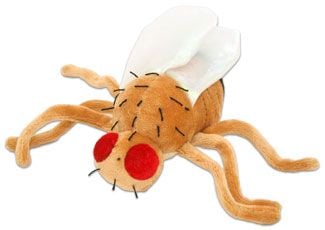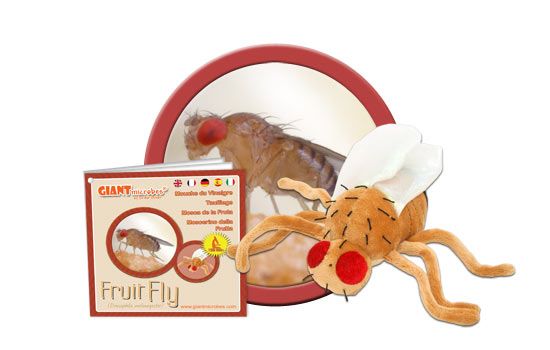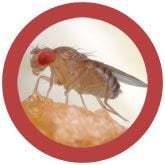Fruit Fly (Drosophila melanogaster)
Out of Stock
Also loves fruit cake!
Product Details
Additional Information
| Sizes | Giantmicrobes are based on actual microbes, cells, organisms and other critters, only 1,000,000 times actual size! Gigantic (GG) 40-60cm XL (XL) 25-38cm Original (PD) 12-20cm Minis (MM) 5-10cm each Keychain (KC) 5-10cm with clip |
|---|---|
| Materials | Plush from all new materials. Stuffed with polyester fiber fill. Surface washable: sponge with water & soap, air dry. |
| Packaging | Each plush microbe includes a printed card with fun, educational and fascinating facts about the actual microbe or cell. |
| Safety | Every product meets or exceeds U.S. and European standards for safety. For ages 3 and up. |
All about Fruit Fly (Drosophila melanogaster)
FACTS: The common fruit fly was elevated to iconic laboratory status in 1901 by Charles W. Woodworth when he bred them on grapes for use in his embryology studies at Harvard. Fellow researcher W. E. Castle later used them at Woodworth's suggestion (though bred on bananas after too many drowned in the grape juice!), as did Thomas Hunt Morgan who made the fruit fly the centerpiece of his seminal work on genetics. It is now one of the most widely studied model organisms.
Fruit flies are well suited to experimental research. Under certain conditions, they can mature from egg to adult in 7 days - so several generations of flies can be examined in less than a month. In addition, because females can lay 100 eggs a day, specimens are easy and inexpensive to obtain. Moreover, males and females are readily distinguished by their size and coloration, and have only four chromosomes with identifiable genetic markers.
While getting to know the fruit fly is certainly its own reward, many researchers are understandably primarily interested in themselves. And since nearly 75% of human disease genes have analogous sequences in the fruit fly genome, the fly is being used in studies covering everything from Alzheimer's to Parkinson's disease to diabetes and cancer, as well as on projects related to aging, immunity, and drug abuse.
But of course, fruit flies are also interested in us: they are often found hovering over fruit, soda cans, and other rotting foods found on casually maintained kitchen countertops.
So if you're not collecting them for research, best to clean up before your home becomes their lab.
| Description | It’s one of the most widely used specimens in labs to study genetics and disease inheritance. They’re cheap to reproduce, easy to maintain, and have short lifespans, making them perfect candidates for laboratory research. |
|---|
| Name | The name describes the behavior and appearance of the bug. Drosophila comes from Greek roots “drosos” and “philos”, meaning dew-loving. Melanogaster comes from Greek roots “melas” and “gaster”, meaning dark belly. |
|---|
| Actual Size | About 2 to 4 millimeters. Females are usually larger than males. |
|---|
| Where It Lives | You can find fruit flies just about anywhere in the world. They especially love your kitchen! They’re the tiny pests that like to gather around spoiled fruit and dumpsters. |
|---|
| History | Thomas Hunt Morgan was the first to discover the unique chromosomal inheritance patterns of Drosophila melanogaster in 1910, for which he won a Nobel Prize in 1933. In 1946, Morgan’s apprentice, Hermann Muller, discovered that x-rays can induce genetic mutation and won a Nobel Prize in 1946. Ed Lewis, Christiane Nusslein-Volhard and Eric Wieschaus won the Nobel Prize in medicine and physiology in 1995 for their work in the 1970’s and 80’s discovering genes that specified the body plan. Finally, Jules Hoffmann won a Nobel Prize for studying innate immunity in fruit flies. These pesky bugs turned out to be a gold mine for biological research! |
|---|
| Fascinating Facts | Fruit flies have a very short lifespan of only 14 days. They undergo complete metamorphosis, completely changing from larva into fly, just like a butterfly! |
|---|






